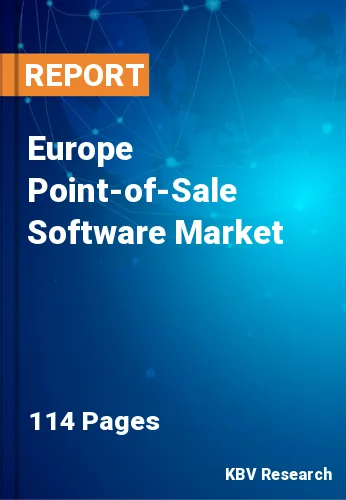The Europe Point-of-Sale Software Market would witness market growth of 9.9% CAGR during the forecast period (2022-2028).
Most point-of-sale (POS) devices were cash registers in companies, but they have now extended to include online payment options such as cards and smartphone applications. In addition to keeping a record of all transactions, the POS system aids in formulating expansion plans for the business. Flexibility, security, improved money management, and streamlined corporate operations are among the primary benefits of cashless transactions. In reality, consumers can already make many forms of cashless digital payments utilizing their mobile phones or credit cards.
In addition, users can now store their card information in mobile wallets and digital payment apps to facilitate cashless transactions. Retailers employ point-of-sale software to perform transactions. Receivers rarely use cash registers, computers, or iPads to enter the products, calculate the total price, and complete the financial transaction.
Most point-of-sale (POS) software also interacts with stock levels to maintain balance. This is the most recent trend in point-of-sale software, rapidly gaining popularity. This system may be accessible through the Internet and is frequently compatible with most POS gear (cash drawers, printers, etc.), i.e., cloud-based software. Furthermore, merchants may access consumer data from any location with an Internet connection, making cloud-based POS systems less expensive and more accessible.
One of the biggest e-commerce markets in Europe is found in Germany. The number of online shoppers, the percentage of people using the internet, and the average annual spending are all higher than in Europe. Total sales in 2021 reached USD 127.5 billion, a 24 percent increase over the previous year. Germany's online population is projected to grow from 62.4 million in 2020 to 68.4 million in 2025. In 2021, the German market experienced a 77 percent penetration of e-commerce. Several German consumers have boosted their online purchases and purchased commodities like groceries and sanitary supplies online due to the severe COVID lockout procedures implemented throughout 2020 and 2021. The regional point-of-sale software market is predicted to increase due to the region's expanding e-commerce sector.
The Germany market dominated the Europe Point-of-Sale Software Market by Country in 2021, and would continue to be a dominant market till 2028; thereby, achieving a market value of $1,296.2 million by 2028. The UK market is anticipated to grow at a CAGR of 9% during (2022 - 2028). Additionally, The France market would exhibit a CAGR of 10.7% during (2022 - 2028).
Based on Application, the market is segmented into Fixed POS, and Mobile POS. Based on Deployment Mode, the market is segmented into On-Premise, and Cloud. Based on Organization Size, the market is segmented into Large Enterprises, and SMEs. Based on End User, the market is segmented into Retail, Restaurants, Hospitality, Warehouse, Healthcare, Entertainment, and Others. Based on countries, the market is segmented into Germany, UK, France, Russia, Spain, Italy, and Rest of Europe.
Free Valuable Insights: The Worldwide Point-of-Sale Software Market is Projected to reach USD 20 Billion by 2028, at a CAGR of 10.6%
The market research report covers the analysis of key stake holders of the market. Key companies profiled in the report include Fiserv, Inc. (Clover Network, Inc.), Oracle Corporation, Toast, Inc., NCR Corporation, Revel Systems (Welsh, Carson, Anderson & Stowe), MSL Solutions Limited (Pemba Capital Partners), Block, Inc., H&L POS (Valsoft Corporation), Idealpos Solutions Pty Ltd and TouchBistro, Inc.
By Application
By Deployment Mode
By Organization Size
By End User
By Country
Our team of dedicated experts can provide you with attractive expansion opportunities for your business.

